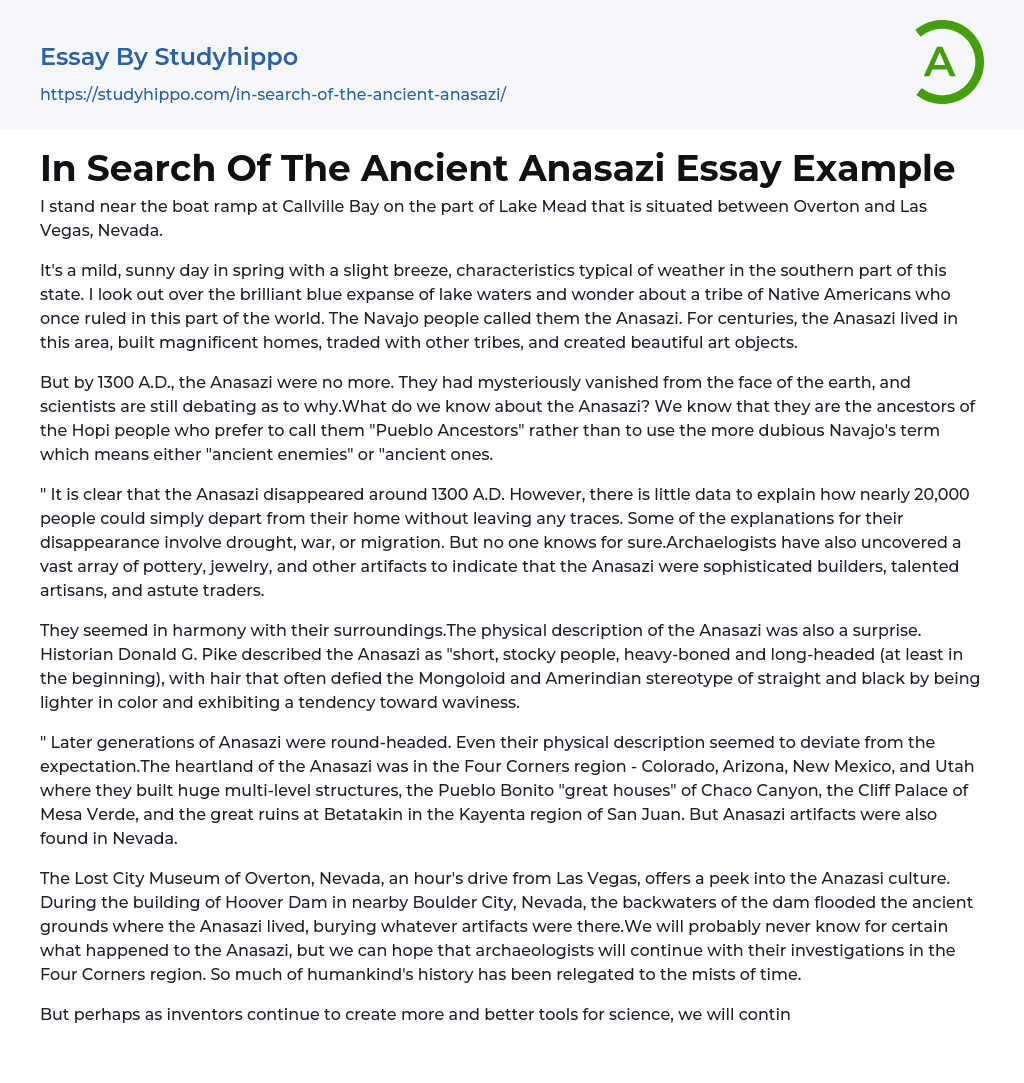My location is at Callville Bay on Lake Mead, situated in the region between Overton and Las Vegas, Nevada.
The southern region of this state experiences a pleasant spring day with sunshine and a gentle breeze. As I gaze at the dazzling blue lake, my thoughts drift towards the Anasazi - an indigenous tribe who once ruled this area. Also known as the Navajo people, the Anasazi resided here for centuries, constructing impressive residences, conducting trade with neighboring tribes and creating exquisite art.
Although the Anasazi people vanished in 1300 A.D., their legacy remains a puzzling enigma that scientists strive to unravel. Nevertheless, we have some knowledge about them, including their association with the Hopi people who identify them as "Pueblo Ancestors." Curiously, the Navajo's name for the Anasazi is contentious and can signify either "ancient enemies" or "ancient ones."
Various
...theories exist regarding the disappearance of the Anasazi around 1300 A.D, including drought, war, or migration. Despite a lack of clear evidence explaining how nearly 20,000 people could disappear without a trace, archaeologists have discovered artifacts such as pottery and jewelry that showcase the Anasazi's expertise in building, artistry, and trade.
Donald G. Pike, a historian, noted that despite their distinct physical appearance, the Anasazi were still well adapted to their environment due to their close connection with it. Pike described the Anasazi as having shorter and stockier builds with heavy bones, elongated heads (initially), and hair that varied from the typical Mongoloid and Amerindian characteristics of straight and dark by being lighter in color and having a tendency towards waviness.
The Anasazi of later generations had round heads and their physical appearance appeared to diffe
from what was expected. They primarily inhabited the Four Corners area comprising of Colorado, Arizona, New Mexico, and Utah where they constructed massive multi-level buildings such as the Pueblo Bonito "great houses" located in Chaco Canyon, the Cliff Palace in Mesa Verde, and the impressive ruins in Betatakin within the San Juan region of Kayenta. However, Anasazi artifacts were also discovered in Nevada.
Located just an hour's drive from Las Vegas, the Lost City Museum in Overton, Nevada provides an opportunity to explore the Anasazi culture. Unfortunately, due to the construction of the Hoover Dam in Boulder City, Nevada, the ancestral land of the Anasazi was flooded by backwaters and all artifacts remain buried. This makes it difficult to fully understand this civilization's fate. Despite this obstacle, archaeologists are hopeful that they will continue their research in the Four Corners region where many significant aspects of our past have been lost over time.
It is possible that if scientific instruments are improved, we may be able to uncover more information about human history, which could include solving the enigma of Anasazi.
- Ranch essays
- Ethnic Group essays
- Travel essays
- Asia essays
- Caribbean essays
- Developing Country essays
- America essays
- City essays
- Africa essays
- Australia essays
- Europe essays
- Georgia essays
- Middle East essays
- New Zealand essays
- South Korea essays
- Thailand essays
- Afghanistan essays
- Dubai essays
- North Korea essays
- Natural Disaster essays
- Earthquake essays
- Fracking essays
- Mountains essays
- Restaurant essays
- Hospitality essays
- Business Travel essays
- Hotels essays
- Tourism essays
- World Tourism Organization essays
- Kids travel essays
- Travel Agency essays
- ecotourism essays
- Air Travel essays
- Sea Travel essays
- Cathedral essays
- Traveling essays
- Fast Food Restaurant essays
- Motel essays
- Cultural Tourism essays
- The real essays
- Airlines essays
- Airports essays
- Boeing essays
- Low-Cost Carrier essays
- Easyjet essays
- Bangladesh essays
- Kuala Lumpur essays
- Malaysia essays
- Manila essays
- Philippines essays




